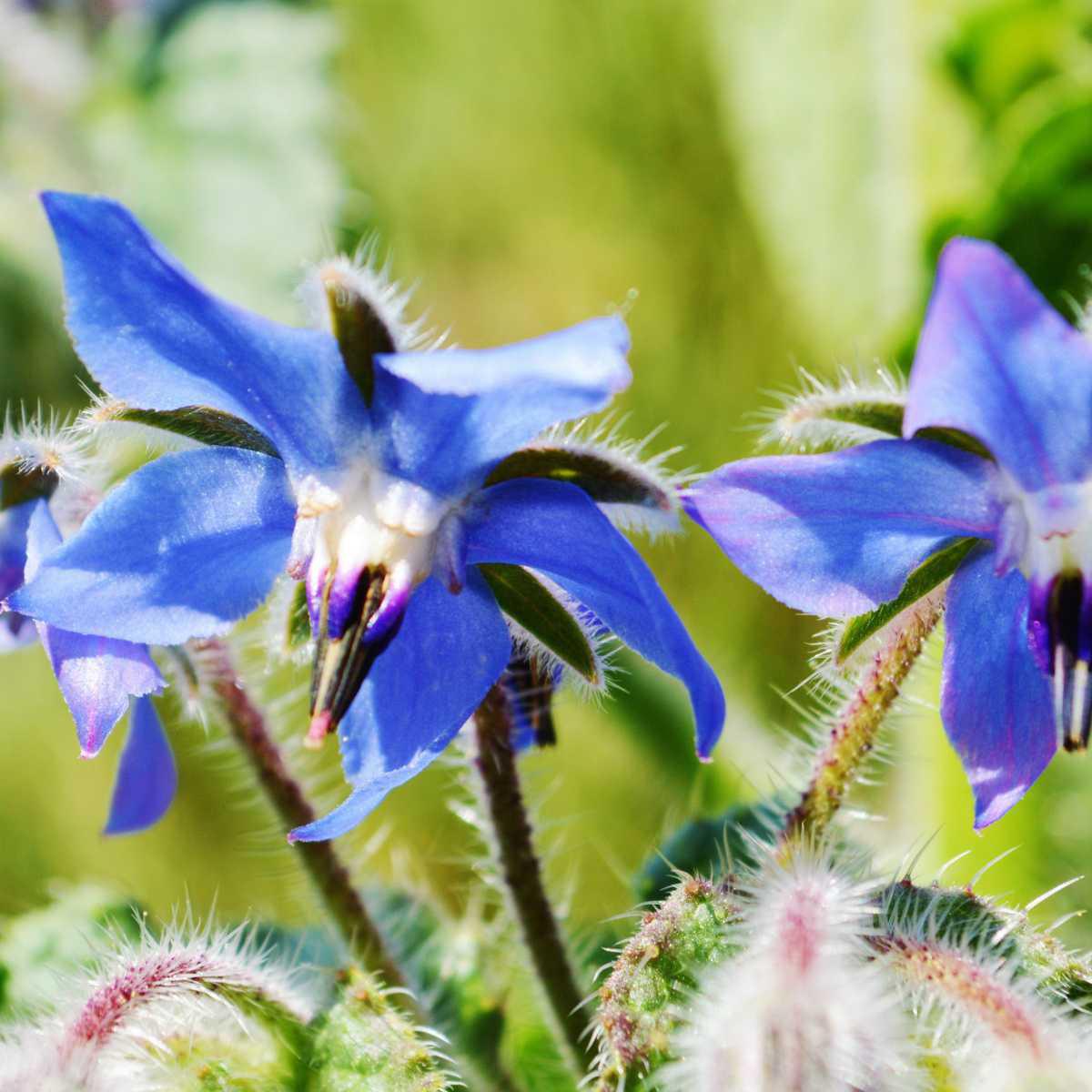Updated 4 January 2024
Common origins
- Widespread in Europe
Botanical classification
- Kingdom: Plantae
- Order: Polemoniales
- Family: Boraginaceae
- Genus: Borage
Components
- Mucilages
- Sugars
- Flavonoids
- Tannins
- Organic acids
- Pyrrolizidine alkaloids
- Vitamin C
- Minerals: potassium nitrate, silica, etc.
- Essential oil (traces)
Parts used
- Whole plant in full bloom, except roots, young shoots (emollient properties)
Organoleptic properties
- Odour: faint, crumpled leaves with a 'cucumber' note
- Flavour: fresh, aquatic, iodised, oyster-like, sweet (flowers), cucumber-like (leaves)
Properties
- Strong diuretic
- Sudorific, febrifuge
- Pectoral emollient
- Tonic
- Calming
- Positive effect on the adrenal glands - Astringent
- Laxative
- Healing
- Anti-inflammatory
Indications
- Cough
- Bronchial and lung diseases (often associated with sadness)
- Flu
- Cystitis
- Inflammation of the urinary tract
- Infectious diseases with fever
- Water retention, oedema
- Rheumatoid arthritis
- Nervous heart problems
- Abscesses (pain), inflammation, burns
- Atopic dermatitis
- Eczema
- Sensitive skin
- Dry skin
- Stretch marks
- Skin aging (prevention)
- Menstrual pain
Precautions / Contraindications
- General precautions for use: Observe physiological doses.
- Contraindicated in pregnant or breastfeeding women
CAUTION: Avoid large doses over a prolonged period due to the presence of pyrrolizidine alkaloids, considered to be hepatotoxic and carcinogenic.
Interactions
- Possible interaction between warfarin and borage-based capsules.
How to use / Current dose
Internal use
- As an infusion, often combined with other plants: 20g per litre of water, infuse for 10 minutes, filter well (to ensure there are no hairs, which can be irritating), drink one cup 2 to 4 times a day.
- Borage Tincture
External use
- Burns, inflammations: applied externally as a compress (fresh leaves).
Cooking
Flowers
- They add colour to salads, are used to colour vinegar and are also eaten candied or macerated in wine.
Leaves
- Cooked like spinach or used in soups.
Find out more about borage
Borage is used in veterinary medicine and farmers have used it to care for calving cows. Used alone or in combination with mallow, it is given as an infusion for 8 days to cleanse the animal and relieve the inflammation that can follow parturition. The whole plant is then added to the feed ration.
The whole plant infusion is used to control inflammatory diseases in cattle and lung diseases in pigs.
Additional information
Habitat and botanical description
Borage is the typical genus that gives its name to the Boraginaceae family.
Borage is a perennial herbaceous plant with hard, short, coarse hairs. It grows between 40 and 70 centimetres tall. Its stem is thick, hairy and branched. The basal leaves are stalked, oval to lanceolate, first appearing in a rosette, with a wavy margin. The stem leaves are smaller, sessile and clasping; the larger ones are alternate, rough and wrinkled. The flowers are a peculiar blue, whitish in the centre. The flowers are semi-nodding. They are made up of 5 fused petals arranged in a star shape and 5 brown sepals fused at the base to form a short, hairy tube. The black stamens are grouped in the centre of the flower to form a protruding cone.
It flowers from April until the first frosts.
It grows in fields, roadsides, gardens and arable land or waste ground and likes dry, sunny places. It is rarely found in uncultivated, stony areas and can be found at altitudes of up to 1,800 metres.
Harvest time
The young seedling is very delicate in spring. As time goes by, the plant becomes stronger and flowers. The flowers are harvested and the whole plant blooms from May to July.
Watch out for bees and other pollinators when picking the flowers, as they are abundant in the summer.
Mythology / History / Anecdotes and traditional virtues
Originally from the Levant, brought by the Crusaders from Damascus, this plant has spread over the centuries throughout France, where it grows spontaneously almost everywhere.
It is said that its name comes from the Syrian "abourash", meaning "father of sweat", because of its long-recognised diaphoretic properties.
In his History of Plants, the famous French botanist Tournefort, a precursor of Linnaeus, pointed out that the flowers of this plant resemble the knurls of a spurge, which immediately distinguishes them from those of bugloss or viper's broom.
In the Middle Ages it was used as an antidepressant. In the seventeenth century, Burton wrote that "borage and ellébore purge the veins of melancholy, and free the heart from those black fumes which make it suffer". If we are to believe the Benedictine Dom Alexandre in his pharmaceutical dictionary (1768), borage is excellent as a diuretic, sudorific, bechic and its flowering properties are excellent.

